Non c’è Natale senza… PanettoneThere is no Xmas without… Panettone
Tra uvette e canditi è di sicuro uno dei dolci più amati del Natale il Panettone!
E’ un tipico dolce milanese, associato alle tradizioni gastronomiche del Natale ed ampiamente diffuso in tutta Italia.
Il panettone tradizionale lombardo è notoriamente quello alto, ma esiste anche la variante bassa e larga piemontese, detta Galup.
LA STORIA
Le origini del panettone sfumano a tratti nella leggenda.
Sono due le storie che godono di maggior credito:
La prima narra di Messer Ughetto degli Atellani, falconiere, abitava nella Contrada delle Grazie a Milano.
Innamorato di Algisa, bellissima figlia di un fornaio, si fece assumere dal padre di lei come garzone e, per incrementare le vendite, provò a inventare un dolce: con la migliore farina del mulino impastò uova, burro, miele e uva sultanina. Poi infornò.
Fu un successo strabiliante, tutti vollero assaggiare il nuovo pane e qualche tempo dopo i due giovani innamorati si sposarono e vissero felici e contenti.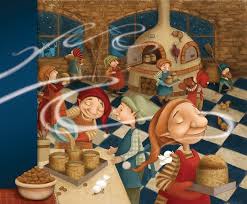
La seconda racconta di un cuoco al servizio di Ludovico il Moro, fu incaricato di preparare un sontuoso pranzo di Natale a cui erano stati invitati molti nobili del circondario, ma il dolce, dimenticato nel forno, quasi si carbonizzò.
Vista la disperazione del cuoco, Toni, un piccolo sguattero, propose una soluzione: «Con quanto è rimasto in dispensa – un po’ di farina, burro, uova, della scorza di cedro e qualche uvetta – stamane ho cucinato questo dolce. Se non avete altro, potete portarlo in tavola.»
Il cuoco acconsentì e, tremante, si mise dietro una tenda a spiare la reazione degli ospiti.
Tutti furono entusiasti e al duca, che voleva conoscere il nome di quella prelibatezza, il cuoco rivelò il segreto: «L’è ‘l pan del Toni». Da allora è il
“pane di Toni”, ossia il “panettone”.
Ma la vera origine del panettone va ricercata nell’usanza diffusa nel medioevo di celebrare il Natale con un pane più ricco di quello di tutti i giorni. Un manoscritto tardo quattrocentesco di Giorgio Valagussa, precettore di casa Sforza, attesta la consuetudine ducale di celebrare il cosiddetto rito del ciocco. La sera del 24 dicembre si poneva nel camino un grosso ciocco di legno e, nel contempo, venivano portati in tavola tre grandi pani di frumento, materia prima per l’epoca di gran pregio. Il capofamiglia ne serviva una fetta a tutti i commensali, serbandone una per l’anno successivo, in segno di continuità.
Anche un’altra realtà storica avvalora la derivazione del panettone dal grande pane di frumento natalizio:
fino al 1395 tutti i forni di Milano (tranne il prestino dei Rosti, fornitore dei più abbienti) avevano il permesso di cuocere pane di frumento solo a Natale, per farne omaggio ai loro clienti abituali.
L’abitudine di consumare pane di frumento a Natale, quindi, è molto antica. Non c’è da stupirsi, perché molte altre città italiane ed europee condividevano l’usanza del pane arricchito della festa.
Solo quello di Milano, però, è diventato il panettone.
Di questa lunga evoluzione sono documentate alcune fasi. Nel 1606, secondo il primo dizionario milanese-italiano (Varon milanes), il Panaton de Danedaa era un Pan grosso, qual si suole fare il giorno di Natale, per metafora un’inetto [sic], infingardo, da poco.
Francesco Cherubini ce ne dà una descrizione più ricca nel suo celebre Vocabolario milanese-italiano in cinque volumi (stampato tra il 1839 e il 1856; il terzo volume M-Q è del 1841). Il Panattón o Panatton de Natal come una “Specie di pane di frumento addobbato con burro, uova, zucchero e uva passerina (ughett) o sultana, che intersecato a mandorla quando è pasta, cotto che sia risulta a molti cornetti. Grande e di una o più libbre sogliamo farlo solo a Natale; di pari o simil pasta ma in panellini si fa tutto l’anno dagli offellai e lo chiamiamo Panattonin – Nel contado invece il Panatton suole esser di farina di grano turco e regalato di spicchi di mele e di chicchi d’uva […].”
La prima fonte a parlare di lievito, invece, è del 1853: il Nuovo cuoco milanese economico, ricettario di Giovanni Felice Luraschi. I cubetti canditi (di cedro) compaiono nel Trattato di cucina, pasticceria moderna (1854) di Giovanni Vialardi, cuoco dei regnanti sabaudi.
La presenza del panettone in un libro piemontese ottocentesco prova l’antichità della diffusione di questo dolce nella regione scelta da Flamigni come sede dei suoi impianti produttivi.
Pietro Verri narra di un’antica consuetudine che nel IX secolo animava le feste cristiane legate al territorio milanese: a Natale la famiglia intera si riuniva intorno al focolare attendendo che il pater familias spezzasse “un pane grande” e ne porgesse un pezzo a tutti i presenti in segno di comunione.
Nel XV secolo, come ordinato dagli antichi statuti delle corporazioni, ai fornai che nelle botteghe di Milano impastavano il pane dei poveri (pane di miglio, detto pan de mej) era vietato produrre il pane dei ricchi e dei nobili (pane bianco, detto micca). Con un’unica eccezione: il giorno di Natale, quando aristocratici e plebei potevano consumare lo stesso pane, regalato dai fornai ai loro clienti.
Era il pan di scior o pan de ton, ovvero il pane di lusso, di puro frumento, farcito con burro, miele e zibibbo. Alla fine del Settecento si verificò una novità inattesa: la Repubblica Cisalpina s’impegnò a sostenere l’attività degli artigiani e dei commercianti milanesi favorendo l’apertura dei forni, mondo di delizie in cui guizzavano indaffarati i prestinee, e delle pasticcerie, regno incantato degli offellee.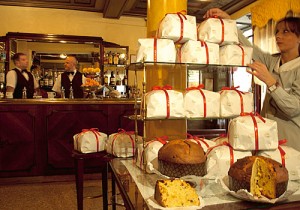
Nel corso dell’Ottocento, durante l’occupazione austriaca, il panettone diventò l’insostituibile protagonista di un’annuale abitudine: il governatore di Milano, Ficquelmont, era solito offrirlo al principe Metternich come dono personale.
La ricetta del panettone viene ripresa da Angelo Vergani nel 1944, fondatore della Vergani, azienda che ancora oggi produce il panettone a Milano.
Il poeta Pastori, uno dei più apprezzati poeti milanesi del ‘900 cita questo tipo di panettone in una delle sue poesie.
RICETTA
I formati del panettone
Il panettone, oggi, è disponibile in due formati: basso e alto. Dal primo è nato il secondo, ma il secondo ha indirettamente fatto evolvere il primo. Ripercorriamo le sue tappe.
Il panettone basso originario.
Come racconta il suo nome, il panettone era un tempo un grosso pane, che fino ai primi del Novecento veniva infornato senza alcun tipo di stampo [per avere un’idea di come fosse]. La cosa era possibile, perché la quantità di grassi in esso contenuta era piuttosto modesta; niente a che fare con i 6÷700 grammi di burro per chilo di farina e i tanti tuorli impiegati oggi da molti pasticcieri (facendo lievitare e infornando senza guaine un panettone moderno, infatti, il risultato sarebbe una focaccia schiacciata, non un panettone).
Il panettone alto.
È Angelo Motta a cambiare le cose. Negli anni Venti, forse influenzato dal lavoro per una partita di duecento kulic per la comunità russa di Milano, sicuramente deciso ad arricchire di grassi il suo panettone, decide di fasciarlo con carta paglia, per dargli uno slancio verticale. Da quest’idea si sviluppa il panettone fungo, forma che è diventata per decenni la foggia classica del prodotto industriale.
Le pasticcerie di Milano, però, hanno continuato a fare il panettone-pagnotta.
Dapprima, senza fasce (o pirottino, come si chiama attualmente la sua forma in un pezzo unico), poi con pirottino basso, reso indispensabile dalla quantità di grassi impiegati.
Oggi i due formati convivono ed è difficile dire quale sia il più tradizionale, visto che è il panettone stesso ad essere cambiato.
Ingredienti per un panettone da 1,5 kg
Farina metà Manitoba e metà 00) 500 gr
Lievito di birra 12 gr
Latte 60 ml
Uova mediograndi
4 intere e 3 tuorli
Zucchero 160 gr
Sale 5 gr
Limoni la scorza grattugiata di uno
Arance candita 40 gr
Cedro candito 40 gr
Uvetta passita 120 gr
Vaniglia 1 bacca
Burro 160 gr
Malto o zucchero 1 cucchiaino
Preparazione
Per preparare il panettone occorrono 3 fasi di lavorazioni, di seguito riporteremo per ogni fase gli ingredienti necessari, in modo da rendere più chiaro lo svolgimento della ricetta.
PRIMA FASE:
Farina 100 gr lievito 10 gr malto 1 cucchiaino (oppure zucchero) latte 60 ml .Per prima cosa mettete in ammollo l’uvetta per farla rinvenire. Sciogliete 10 gr di lievito di birra e il malto (o lo zucchero) in 60 ml di latte tiepido, quindi incorporate la farina e impastate fino ad ottenere un impasto liscio e omogeneo
che metterete in una ciotola coperta con pellicola trasparente a lievitare a 30° fino al raddoppiamento del volume (circa 1 ora).
SECONDA FASE:
Al primo impasto dovrete aggiungere: Farina 180 gr; lievito 2 gr; uova 2 intere; burro morbido 60 gr; zucchero 60 gr.
Unite al primo impasto lievitato le uova, il lievito di birra sbriciolato e la farina, impastate con le mani poi aggiungete lo zucchero e in ultimo il burro ben morbido (a temperatura ambiente); impastate fino ad ottenere un composto liscio e non appiccicoso che adagerete in una ciotola coprite la ciotola con pellicola trasparente e lascerete lievitare a 30° per circa due ore, o fino al raddoppiamento del volume.
TERZA FASE:
Al secondo impasto lievitato aggiungete: farina 220 gr; zucchero 100 gr; uova 2 intere e 3 tuorli ; sale 5 gr; burro morbido 100 gr; limone biologico; la scorza grattugiata di 1 arancia candita a cubetti; 40 gr cedro candito a cubetti 40 gr; uvetta 120 gr; vaniglia 1 bacca.
Unite il secondo impasto lievitato a 2 uova intere e 3 tuorli e a 220 gr di farina.
Impastate per almeno 10 minuti in modo che l’impasto prenda una bella consistenza elastica e poi aggiungete lo zucchero e il sale.
Quando tutti gli ingredienti saranno assorbiti, aggiungete in due volte il burro ammorbidito e, a seguire, la frutta candita (arancia e cedro) la scorza del limone grattugiata, l’uvetta precedentemente ammollata (se volete potete ammollarla nel rum o in un altro liquore di vostro gradimento) e strizzata; volendo potete aggiungere degli altri aromi a vostro piacimento per rafforzare il profumo dell’impasto (arancia, limone, vaniglia, rum, ecc…).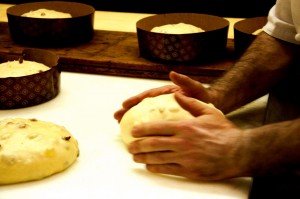
Lasciate lievitare l’impasto a 30° mettendolo in una ciotola coperta da pellicola trasparente fino al raddoppiamento del suo volume (almeno 2 ore). Nel frattempo, imburrate e rivestite uno stampo da panettone (il diametro dovrà essere di 18 cm e alto 10 cm, se non lo avete potete usare due pirottini di carta da 750 gr l’uno) con della carta forno (oppure utilizzate uno stampo di carta per panettone) e quando il volume dell’impasto sarà raddoppiato, estraetelo dalla ciotola, impastatelo di nuovo su di un piano poco infarinato e dategli forma sferica: posizionatelo dentro allo stampo da panettone con la parte più liscia verso l’alto.
Lasciatelo lievitare coperto fino a che l’impasto non arrivi a filo dello stampo (almeno altre due ore).
Quando l’impasto sarà a filo dello stampo, mettetelo in un luogo areato per 10 – 15 minuti in modo che sulla superficie si formi una specie di pellicola più asciutta, dopodiché incidete a croce la sommità e mettete al centro della croce un cubetto di burro (grande quanto una noce). Mettete su di una teglia da forno posta sulla parte inferiore di quest’ultimo, una ciotolina d’acqua e infornate in forno statico a 200° per circa 10 – 15 minuti, quindi abbassate a 190 e lasciate cuocere per altri 10 – 15 minuti. Se la superficie risultasse troppo scura o tendesse a colorirsi troppo in fretta, abbassate ancora a 180 e proseguite la cottura.
In totale il panettone dovrà cuocere per 1 ora. Una volta cotto, estraete il panettone dal forno e lasciate raffreddare.
Il vostro panettone è ora pronto per essere servito!!! Buone feste!!!
Among raisins and candied fruit is certainly one of the most beloved Christmas sweets: the Panettone!
It ‘a typical cake from Milan, associated with the culinary traditions of Christmas and widespread throughout Italy.
The traditional panettone of Lombardy is known that high, but there is also the variant low and wide of Piedmont, called Galup.
HISTORY
The origins of panettone sometimes fade into legend.
There are two stories that enjoy greater credit:
The first tells of Messer Ughetto of Atellani, falconer, lived in Contrada delle Grazie in Milan. In love with Algisa, beautiful daughter of a baker, he became the father take her as an apprentice, and to increase sales, he tried to invent a dessert: the best kneaded flour mill eggs, butter, honey and raisins. Then it baked.
It was an amazing success, everyone wanted to try the new bread and some time later the two young lovers were married and lived happily ever after.
The second tells of a cook in the service of Ludovico il Moro that was instructed to prepare a sumptuous Christmas dinner to which were invited many nobles of the district, but the sweet, forgotten in the oven, almost charred. Given the desperation of the cook, Toni, a little kitchen boy, proposed a solution: “With how much is left in the pantry a little ‘flour, butter, egg, lime zest and some raisins this morning I cooked this cake. If you have nothing else, you can bring it to the table”. Cook agreed and, trembling, stood behind a curtain to spy on the reaction of the guests. Everyone was thrilled and the Duke, who wanted to know the name of that delicacy, the chef revealed the secret: “This is’ the bread of Toni.” Since then it has the “Pan de’ Toni”, or the “Panettone”
But the true origin of the cake to be found in the custom prevalent in the Middle Ages to celebrate Christmas with a bread richer than everyday. A late fifteenth century manuscript of George Valagussa, preceptor of the house of Sforza, attests to the ducal habit of celebrating the so-called rite of Ciocco:
On the evening of December 24 was placed in the fireplace a big piece of wood and, at the same time, they were brought to the table three large loaves of wheat bread, a great value for the era. The householder gave a slice to all diners, holding one for the following year, as a sign of continuity.
Another historical reality supports the derivation of the Panettone from the large wheat Christmas bread:
up to 1395 all furnaces Milan (except the “prestino dei Rosti”, provider of the most well-off) were allowed to bake wheat bread only at Christmas, to pay homage to their regular customers.
The habit of wheaten bread at Christmas, then, is very old. No wonder, because many other Italian and European cities shared the tradition of the enriched feasts bread.
Only that of Milan, however, has become the Panettone.
Some stages of this long evolution are documented. In 1606, according to the first Milanese-Italian Dictionary (Varon milanes), the “Panaton de Danedaa” was a “pan grosso” (big bread), which is usually done on Christmas Day, metaphor for an inept [sic], slothful.Francesco Cherubini gives us a more rich description in his famous Milanese-Italian vocabulary in five volumes (printed between 1839 and 1856. the third volume M-Q is from 1841). The “Panattón or Panatton de Natal” as a species of wheat bread decorated with butter, eggs, sugar and raisins (ughett or sultana), which, intersected like almond when dough, once cooked it is to many croissants. Great one or more pounds we usually only do at Christmas, of equal or similar dough but called “panellini” are made all year around by “offellai” and we call them “Panattonin” – In the countryside instead the Panatton is usually made with turkish wheat flour and filled with apples cloves and grapes […].
The first source to mention yeast, however, is of 1853: the New Economic Milanese chef, cookbook from John Felice Luraschi. The diced candied fruit (cedar) appear in the Treaty of kitchen, modern pastry (1854) from Giovanni Vialardi, chef of kings of Savoy.
The presence of the panettone into a nineteenth century Piedmontese book proves the antiquity of the spread of this sweet in the region chosen by Flamigni as the site of its production plants. Pietro Verri tells the story of an ancient custom that in the ninth century animated the Christian festivities linked to the Milan area: at Christmas the whole family would gather around the hearth waiting for the pater familias would break “a large bread” and gave it a piece at all present as a sign of communion.
In the fifteenth century, as ordered by the ancient statutes of the guilds, the bakers in the shops of Milan kneaded the bread of the poor (millet bread called pan de MEJ), it was forbidden to produce the bread of the rich and nobles (white bread, said micca ). With only one exception: on Christmas Day, when aristocrats and plebeians could eat the same bread, given by the bakers to their customers.
It was “pan di scior” or “pan de ton”, ie the bread of luxury, pure wheat, stuffed with butter, honey and raisins. At the end of the eighteenth century there was an unexpected novelty: the Cisalpine Republic undertook to support the work of milanese artisans and merchants, favoring the opening of the ovens, the world of delights where the “prestinee” busy darting, and pastries, enchanted kingdom of “offellee”.
In the nineteenth century, during the Austrian occupation, the panettone becomes the irreplaceable character of a yearly habit: the governor of Milan, Ficquelmont, he used to offer it as a personal gift to Prince Metternich. The recipe of the panettone is taken by Angelo Vergani in 1944, founder of Vergani, a company that still produces the panettone in Milan. The poet Pastori, one of the most popular milanese poets of the ‘900 mentions this type of cake in one of his poems.
Recipe
The formats of the panettone
Panettone, today, is available in two formats: low and high. From the first was born the second, but the second has indirectly made to evolve the first. Retrace his steps.
The original low panettone.
As its name says, the panettone was once a big bread, which until the early twentieth century was baked without any kind of mold [to get an idea of how it was]. The thing was possible, because the amount of fat contained in it was quite modest; nothing to do with the 6 ÷ 700 grams of butter per kilo of flour and the many yolks used today by many confectioners (pushing up and baking a modern panettone without sheaths, in fact, the result would be a flattened focaccia, not a Panettone).
The high panettone.
Is Angelo Motta to change things. In the twenties, perhaps influenced by the work for a batch of two hundred kulic for the Russian community in Milan, definitely determined to enrich its Panettone of fats, decided to wrap it with straw-paper, to give it a vertical thrust. From this idea is developed the panettone fungus, shape that for decades has become the classic shape of the industrial product. The pastry shops in Milan, however, have continued to do panettone-loaf.
At first, no bands (or paper cups, as it’s called today its form in one piece), then with short paper cups, made indispensable by the amount of the fats used. Today the two formats coexist and it is difficult to say which is the more traditional, as is the panettone itself to be changed.
Ingredients for one panettone of 1.5 kg
Half Manitoba flour and half 00 500 gr (or 500 gr of all pourpose floor)
Dry Yeast 5 gr
Milk 60ml
Medium-large eggs 4 whole and 3 egg yolks
Sugar 160g
Salt 5 grams
The grated rind of one lemon
Orange candied fruits 40 gr
Citron candied fruits 40 g
Raisins 120 gr
1 vanilla berry
Butter 160 gr
Malt or sugar 1 teaspoon
Preparation
To prepare the panettone it requires 3 steps of manufacturing, below we report for each stage the necessary ingredients, in order to make more clear the execution of the recipe.
STEP ONE:
Flour 100g
Yeast 10 gr
malt 1 teaspoon (or sugar)
60 ml milk.
First, soak the raisins to revive her. Dissolve 10 grams of yeast and malt (or sugar) in 60 ml of warm milk, then add the flour and knead until get a smooth and homogeneous dough that you will put in a bowl covered with plastic wrap to rise to 30 ° up to a doubling of the volume (about 1 hour).
STEP TWO:
You’ll have to add to the first mixture:
180 g flour;
yeast 2 grams;
2 whole eggs;
soft butter 60 g;
60 g sugar.
Combine to the first leavened dough eggs, crumbled yeast and flour, knead with your hands then add the sugar and finally the butter softened at room temperature; knead until mixture is smooth and not sticky put in a bowl cover with plastic wrap and leave to rise to 30 ° C for about two hours, or until the doubling the volume.
STEP THREE:
Add to the second dough:
220 g flour,
100 grams sugar,
2 whole eggs and 3 yolks,
salt 5 grams,
100 grams soft butter,
grated rind of 1 organic lemon,
diced candied orange 40 g,
diced candied citron 40 g,
120 g raisins,
1 vanilla berry.
Add the 2 eggs and 3 egg yolks and 220 grams of flour.
Knead for 10 minutes so that the mixture takes a nice smooth consistency, then add the sugar and salt.
When all the ingredients are absorbed, add the softened butter in two times and, thereafter, the candied fruit (orange and citron) the grated lemon rind, raisins previously soaked (if you want you can soak in rum or other liquor to your liking) and squeezed; if you like can add other flavors as you wish to strengthen the fragrance mix (orange, lemon, vanilla, rum, etc …).
Leave the dough to rise at 30 ° by putting it in a bowl covered with plastic wrap until the doubling of its volume (at least 2 hours). Meanwhile, buttered and lined a mold for panettone (diameter will be 18 cm and 10 cm high, if not have it you can use two paper cups of 750 grams each) with greaseproof paper (or use a paper mold for panettone) and when the volume of the ‘dough has doubled, remove it from the bowl, knead again on a slightly floured surface and give it a spherical form: place it inside the mold with the smoother part upward. Let rise covered until the dough does not come to the edge of the mold (at least two more hours).
When the dough is flush with the mold, put it in a ventilated place for 10 to 15 minutes so that a kind of film drier is formed on the surface, then carve a cross on the top and place in the center of the cross a cube of butter (the size of a walnut). Put on a baking sheet on the bottom of the oven with a bowl of water beside and bake at 200° for about 10 – 15 minutes, then lower to 190° and cook for another 10 to 15 minutes. If the surface is too dark or tended to color too quickly, lower still at 180° and continue cooking. In total, the panettone will bake for 1 hour. Once cooked, remove the panettone from the oven and let cool. Your cake is now ready to be served !!! Happy Holidays!!!
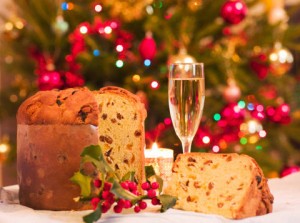






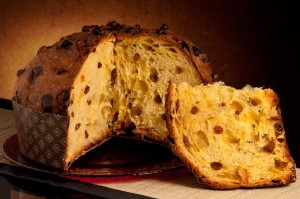
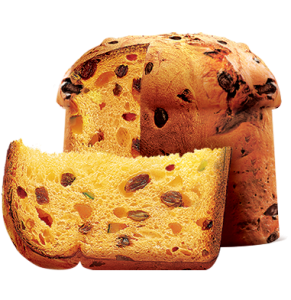
Leave a comment